If skills-based hiring is the future of recruitment, are take home assignments the answer? Maybe, but only if candidates are encouraged to actually finish them.
Skills-based hiring is a phenomenon that’s surging in popularity, and for good reason. According to new data sourced from Deloitte, 89% of executives say that skills are becoming important for the way organizations are defining work, deploying talent, managing careers, and valuing employees.
For those unfamiliar with the benefits, skills-based organizations are 107% more likely to place talent effectively, 98% more likely to retain high performers, and 98% more likely to have a reputation as a great place to grow and develop professionally.
Unfortunately, where many organizations let themselves down is the way they choose to implement this philosophy through methods like take home assignments.
Let’s face it: none of us are particularly fond of completing homework, especially if we aren’t stimulated, or have the right motivation to see the task through.
Much to the chagrin of many recruiters, one of the major pain points of using take home assignments to test skills is actually getting candidates to complete them – but is there a way around this?
What are take home assignments and how do they work
Depending on the context and the desired outcome, take home assignments can come in many forms. In recruitment settings, a take home assignment might be a coding challenge, a writing sample, or a marketing campaign proposal.
While the content might be different from a traditional school based assignment, the outcome is the same: to assess the skill level or knowledge that the author possesses.
When used as a form of screening or skills testing during the recruitment process, the key feature of take home assignments is that they are completed independently by the individual receiving the assignment, without direct supervision or collaboration with others.
When best practices are applied, this allows the candidate to showcase their ability to work independently and produce high-quality outcomes on their own. In contrast, the hiring manager is then able to use the results to make data driven decisions, and reap the rewards of skills-based hiring practices.
Unfortunately, most candidates aren’t big fans of take home assignments – especially when they’re expected to give up hours of their own time with no financial compensation aside from the possibility of landing a new job.
Thankfully, the rewards of using take home assignments as a skills-based hiring tool are worth it for hiring managers who are able to overcome this obstacle.
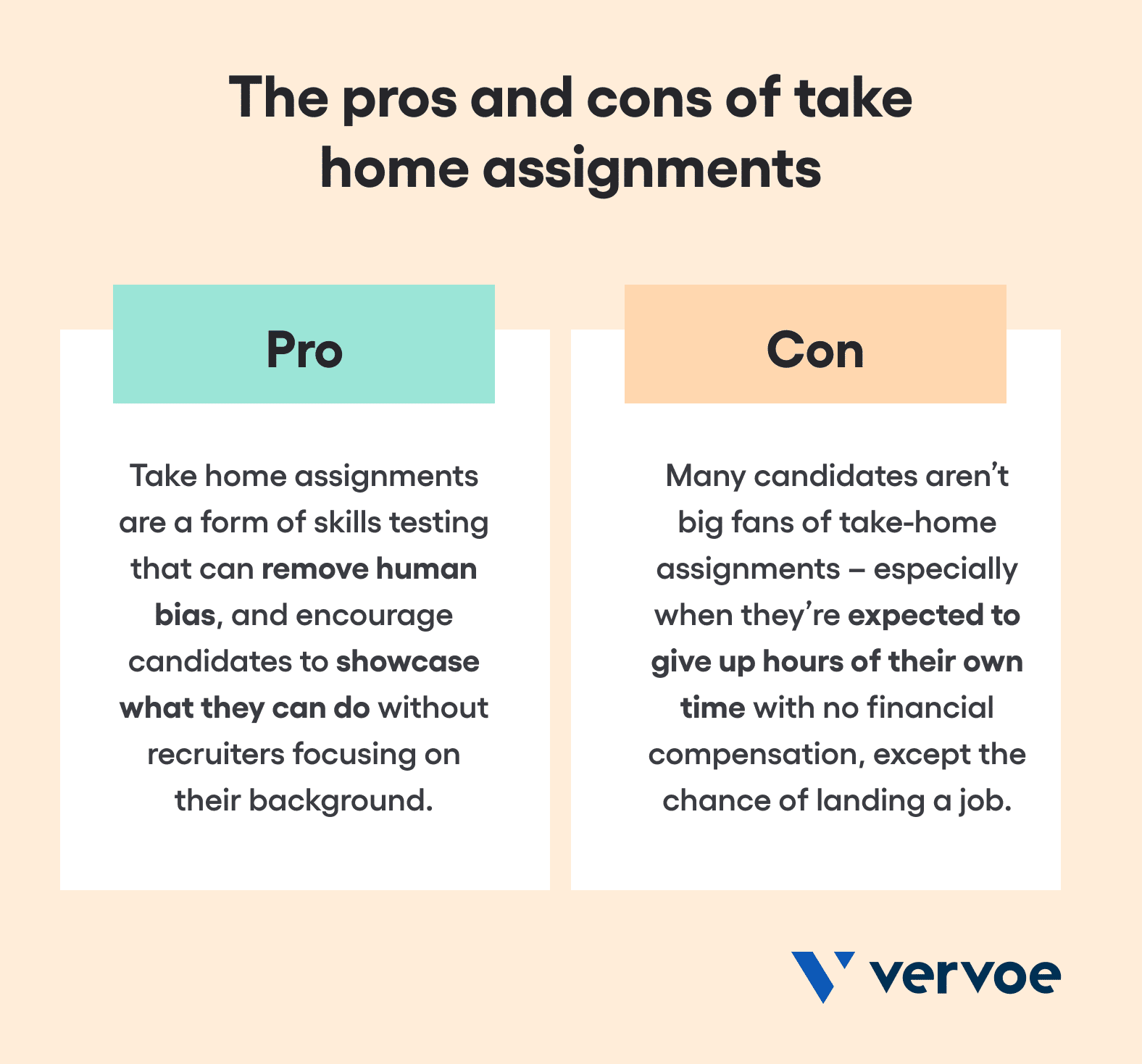
3 key benefits of using take home assignments in recruitment
Take home assignments can be used in different stages of the recruitment process. As an example, a company may send a take-home assignment to a candidate after initial screening processes, before inviting them to an in-person interview or the next stage of the recruitment process.
Alternatively, a take home assignment may be given to candidates as part of the final stage of the hiring process, before an offer is made. Regardless of when these forms of skills assessments are introduced, some of the key benefits on offer for recruiters include the following.
Skills testing and validation
Take home assignments provide a more accurate assessment of a candidate’s relevant skills and knowledge than traditional recruitment practices like resume screening and job interviews.
As projects can be designed to reflect the actual work that the candidate would perform in the job, this allows employers to evaluate the candidate’s ability to apply their skills to real-world scenarios rather than making judgements derived from claims listed on a resume.
Improves diversity and inclusion
Did you know that companies with a diverse workforce perform 35% better than those without? Numbers don’t lie, and companies that proactively pursue this approach in their hiring practices are more likely to reap the rewards through increased performance and productivity.
To remove the chance of human bias affecting the recruitment process, a growing number of organizations are using take home assignments as a tool to remove the human element, and make decisions based on data.
Saves time and resources
Depending on factors like the hiring manager, the interview structure and whether it’s necessary to meet with multiple team members as part of the interview, a typical in-person job interview lasts between 45 and 90 minutes.
Shifting the interview portion further down the hiring process steps helps companies focus on quality candidates rather than the search for quality candidates, and using take home projects can help to relieve the pressure on recruiters to track down top talent.
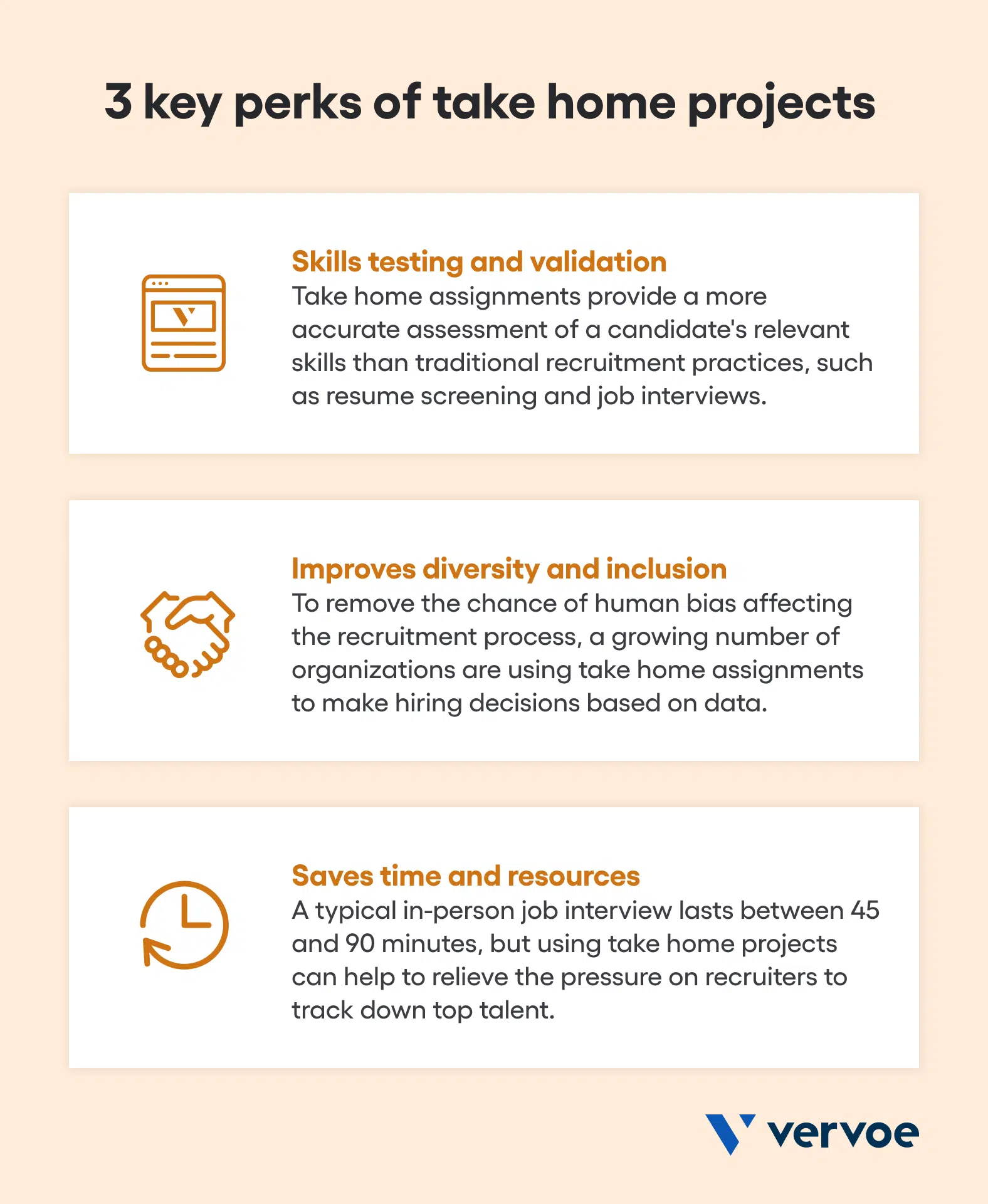
How Deloitte used take home projects to unearth top talent
Even today, companies still rely too much on interviews when hiring, which has been shown to be a poor predictor of future performance and introduces opportunities for bias. As an alternative, some of the biggest organizations in the world are taking a different approach.
According to Geoff Tuff, Principal at Deloitte Consulting LLP, prioritizing take home assignments over job interviews can help recruiters better match true competency with the job requirements. When applying these tools with his colleague Jeff Johnson, Tuff found that the results spoke for themselves.
“One of us (Jeff) spent several years hiring writers for our firm. He used a scenario-driven writing assignment, administered after a short introductory call, to assess skills. Many publications use writing or editing tests for job candidates, but Jeff approached the task more analytically than most.”
When reporting their findings to the Harvard Business Review, Tuff and Johnson found that their approach not only helped them to unearth better writers, but it also aided them in better understanding their process while simultaneously giving the candidates a preview of what working with them would be like.
“After receiving the assignment, he conducted a follow-up conversation to understand not just what was on the page, but the candidate’s choices in crafting it. Not only did this give us a sense of how a candidate would perform, but they got a much better sense of the job itself, as we related elements of the task to actual role expectations. By using the same exercise repeatedly, we also built a database of responses over time, or a positive feedback loop to better assess the next candidate.”
Why take home assignments may not have the intended results
Take home assignments are commonly used in recruitment as a way to evaluate a candidate’s skills and abilities in a practical and relevant way. Employers can use these assignments to assess a candidate’s critical thinking, problem-solving, and communication skills, as well as their ability to meet deadlines and produce high-quality work.
Unfortunately, the fundamental problem with many take home assignments is the fact that a candidate has to put in time that the employer doesn’t. A candidate may spend hours on a project, only for the employer to reject them after only a cursory glance.
As much as you want to vet candidates for the right skill level, it’s important to be competitive with how other companies are hiring, so you don’t lose out on top talent.
If you ask a candidate to complete a take home assignment before engaging them in the next step of an interview process, they might say they are happy to do it.
In reality, the truth is that they will often wait to start it until completing any other interviews they have lined up in hopes of getting a decision from another employer sooner. In highly competitive industries that are recruiting for in-demand skilled talent, this is where take home projects can become problematic.
To solve this problem, the solution is to do everything in your power as a hiring manager to ensure the take home project is relevant, straightforward and worth the time it takes to complete – but where do you start?
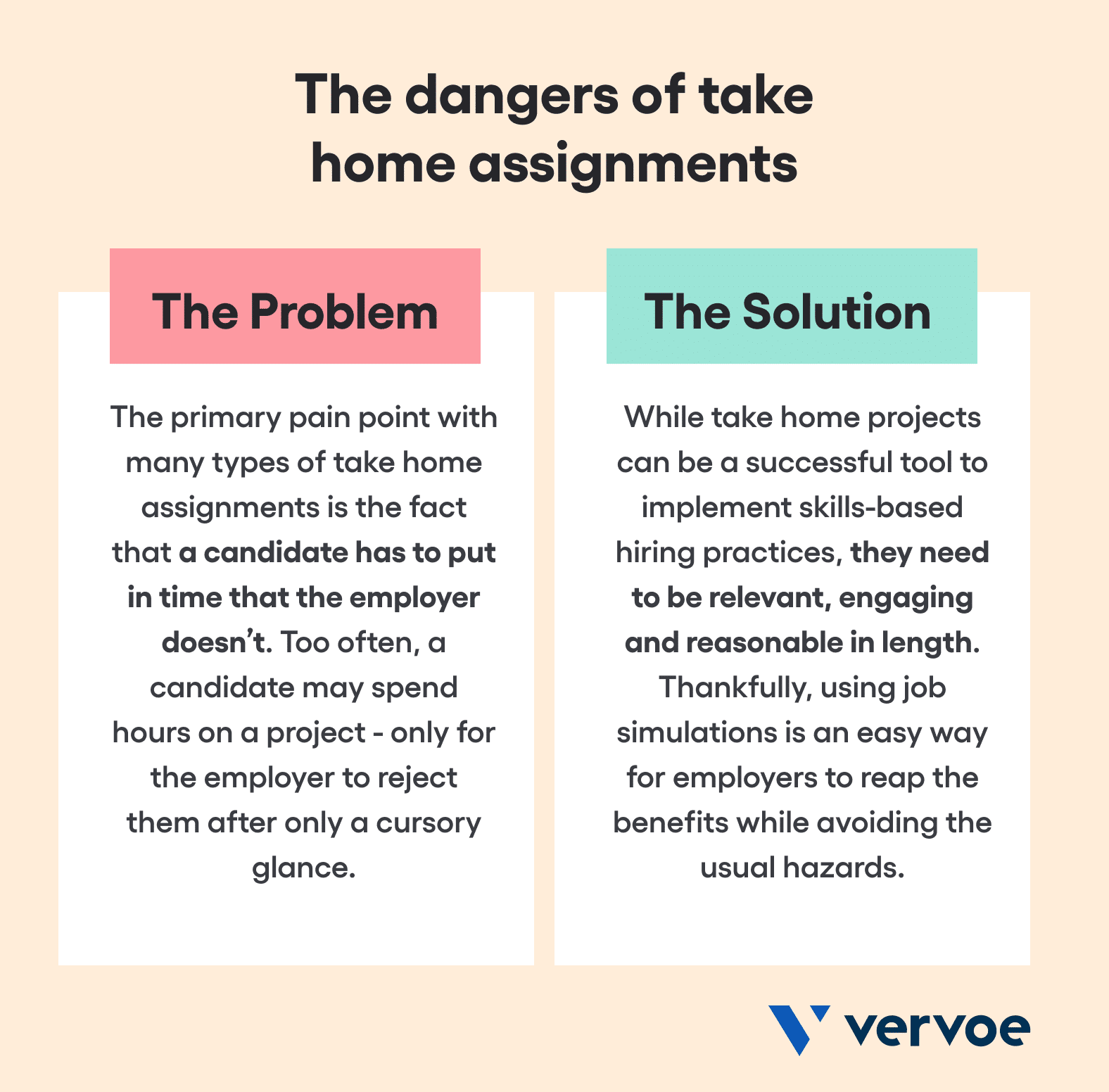
6 ways to boost your completion rates for take home assignments
While take home assignments can be an effective way to assess a candidate’s skills and abilities, some candidates may view them as an additional burden or an unnecessary step in the recruitment process.
If your organization’s take home project completion rate leaves a lot to be desired, then the good news is that there are plenty of easy steps to take to encourage candidates to not only finish these tasks, but to approach take home assignments with enthusiasm.
Streamline your hiring process
Considering that 60% of candidates stop midway through a job application if the hiring process is too complex or strenuous, don’t make the procedure any more difficult than it needs to be.
Therefore, if you want candidates to actually complete any take home assignments issued to them, don’t expect them to sit through four to five rounds of interviews as well. While this philosophy should apply regardless, be clear with your candidates about what a candidate needs to complete and when it’s due.
Provide clear instructions
Firstly, let candidates know about the take home project beforehand so that they’re not caught off guard. When issuing them a task, ensure that the instructions for the assignment are clear, concise, and easy to understand.
Provide examples and resources if needed, so candidates know exactly what is expected of them. Candidates will be more engaged if they understand the reasoning behind the assignment and how it will be used to make hiring decisions, so be as transparent as you can.
Make the tasks relevant
It’s no easy feat keeping candidates engaged during the recruitment process, so do your best to ensure that the take home project is directly related to the job requirements and responsibilities you’re advertising for.
In fact, 61% of new hires say their new job is different from what they expected, so candidates are much more likely to engage with an assignment if they see how it relates to their potential role, in addition to working wonders for reducing attrition.
Give candidates enough time
Many people applying for a new role are already juggling existing work and family responsibilities, and asking them to submit hours worth of unpaid work won’t exactly present your organization as a favorable company to join.
This one isn’t exactly rocket science, but be sure to provide candidates with enough time to complete the take home project. Unless you’re willing to offer applicants paid compensation, aim to keep your take home project as short and straightforward as possible to keep them engaged.
Showcase your company culture
The culture at your organization sets expectations for how people behave and work together, and how well they function as a team. In this way, culture can break down the boundaries between siloed teams, guide decision-making, and improve workflow overall.
To set the tone and find candidates who align with the company culture – and are therefore more engaged and interested in their work – use a take home project as an opportunity to showcase what candidates can expect from a career with your organization .
Get the format right
In an era when candidates can use a broad range of tools like ChatGPT, finding the right format for a take home project can be tricky. The solution? The same desired outcome, but in a new format: job simulations.
While seeing someone do the job before they get the job sounds ideal for any organization looking to improve their quality of hire, using job simulations as a take home project format reduces the odds of candidates using the work of other people or sources, and pulling it off as their own.
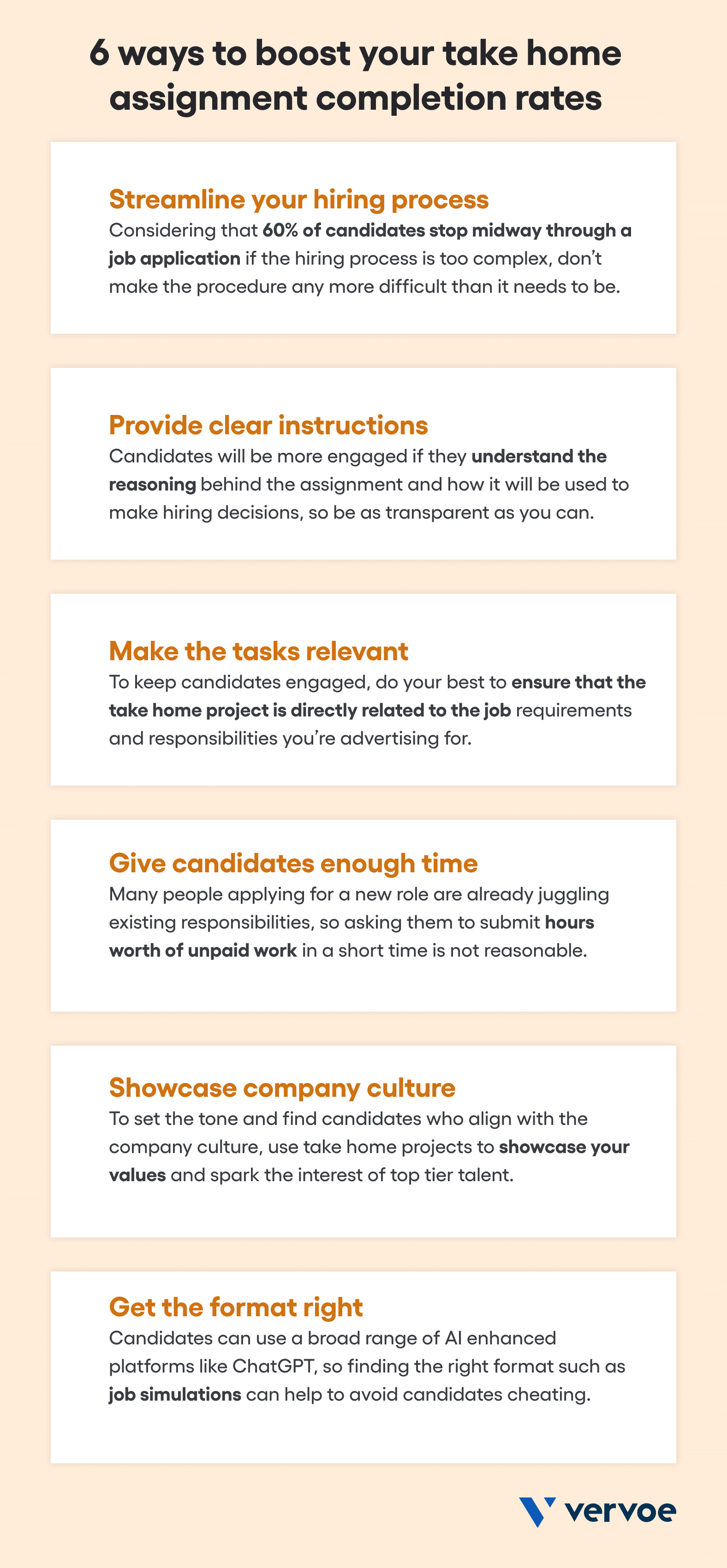
Why job simulations are the ultimate type of take home project
If your organization wants to reap the rewards of take home assignments without taking on any of their potential risks, then skills assessments that include job simulations are considered to be the easiest way to practice skills-based hiring.
Tasks in a skills assessment can be immersive, such as a coding challenge or job simulation, or instead target soft skills, such as motivation, communication, and emotional intelligence. Whatever a certain role commands, skills-based hiring can use role-specific assessments customized to reflect the relevant metrics of success.
The great thing about skills assessments is that they can be used at any stage of the hiring funnel to streamline a list of candidates suitable for job interviews. As they’re adaptable to job-specific performance metrics, skills assessments can be used in short formats at the early stages of a recruitment drive, or get into the nitty gritty if you’re stuck on two or three final contenders.
In addition, replacing take home assignments with job simulations means that recruiters can unlock the benefits of the former in a fraction of the time, while candidates will spend minutes – not hours, days or weeks – showcasing what they can do. Put simply, everybody wins.
Ultimately, making hiring decisions based on data instead of guesswork or intuition is not only a smarter way to hire with confidence – it’s the future of recruitment.
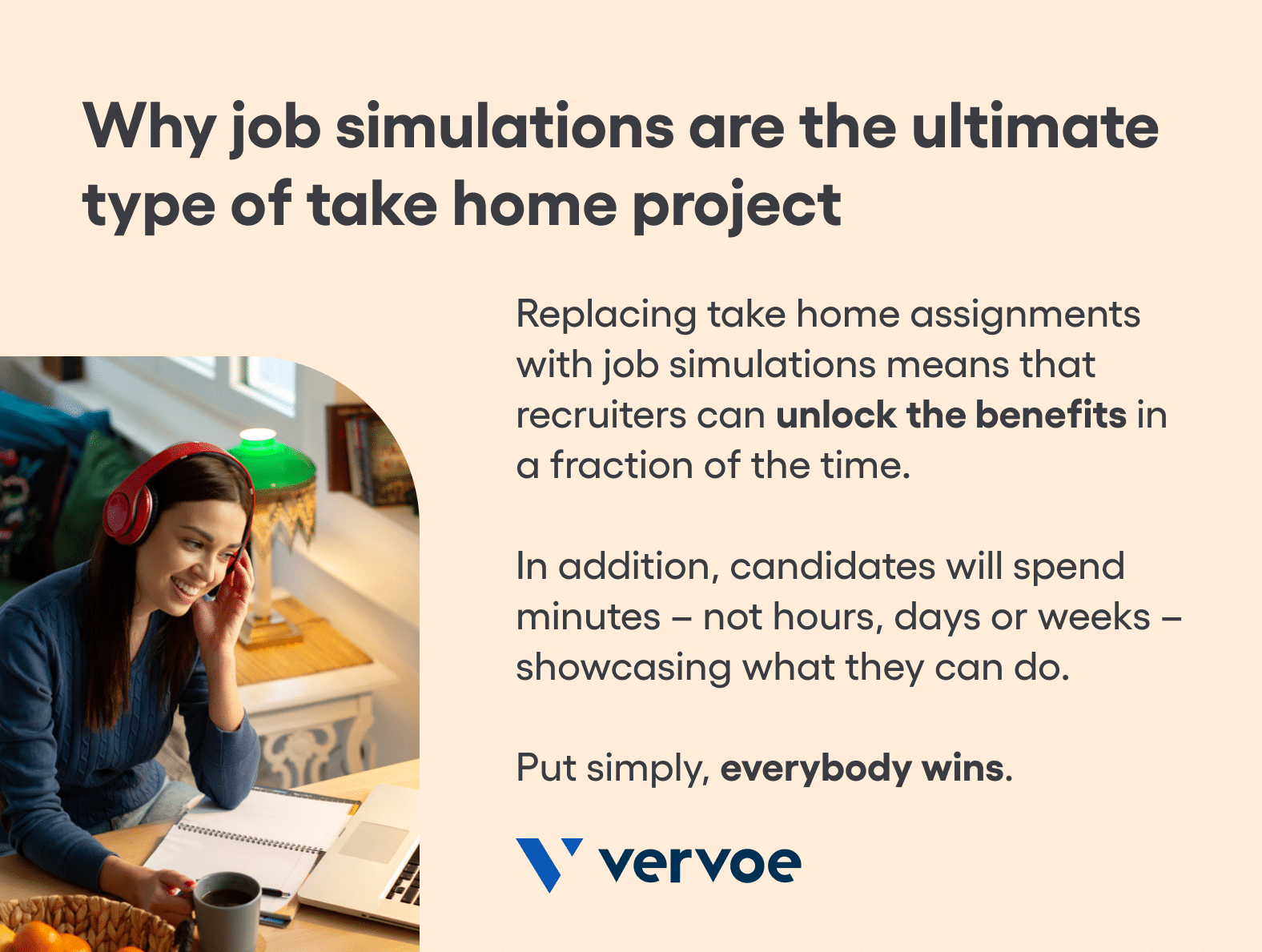
Talent stands out with job simulations
Vervoe is an end-to-end AI-powered solution that is proudly revolutionizing the hiring process through skills testing, job simulations, and machine learning recruitment.
By empowering businesses to create role specific assessments designed to suit the unique requirements of a position, Vervoe predicts performance through skills-based hiring practices that showcase the talent of every candidate.
Ultimately, our job simulations focus on the work — and not the person. To see people do the job before they get the job, book a demo today and let our experienced team run you through Vervoe’s full range of ready-made and tailored solutions.


















